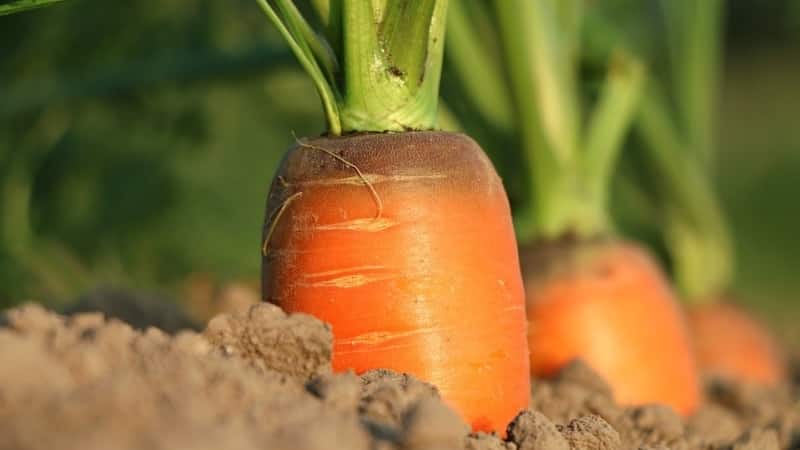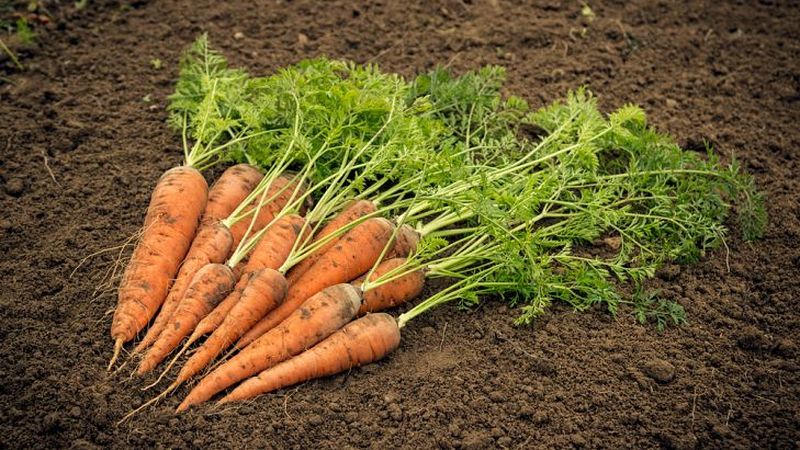The main reasons why carrots do not grow in the garden
It happens like this: a gardener sowed seeds according to all the rules, carefully looked after the beds, but the carrots do not grow. What is the reason and what measures should be taken to save the harvest into which labor, hope and expectations have been invested?
In this article we will tell you why carrots do not grow in the garden and how to avoid this.
For what reasons do carrots grow poorly?

There are several main reasons:
- improper care;
- unfavorable climatic conditions;
- incorrect landing;
- violation of crop rotation rules;
- microclimate mismatch;
- excess or lack of light;
- improper watering;
- poor quality planting material;
- too high sowing density.
Let's look at each of the reasons in detail.
Improper care
Carrots are a capricious vegetable. Failure to follow the care rules will affect the quality of the crop:
- untimely thinning - due to lack of free space, root crops grow small or are not formed at all;
- abundant or scanty watering - this prevents carrots from fully developing;
- lack of hilling - the vegetable stops growing, and its upper part turns green;
- improper feeding - excess organic matter contributes to rotting of the root crop during storage.
Adverse climatic conditions
External factors, such as climatic conditions, also affect the harvest result. Carrot seeds germinate at temperatures from +3°C, and temperatures from +18°C to +24°C are considered optimal for full growth and maturation. A further increase in temperature will slow down the growth of the vegetable.
Incorrect landing
When planting seeds in dense or clayey soil, the optimal distance from the surface is 1 cm, in loose, sandy soil - 4-5 cm. If you plant the seeds deeper, when watering, the moisture will not reach the roots. Keep an eye on the forecast: if a dry season is expected, sow deeper, if wet, sow shallower.
Violation of crop rotation rules
The main mistake is sowing the future crop in the same place where the vegetable grew last year. Also, due to common pests, carrots should not be sown after lettuce and parsley.
Microclimate mismatch
In dry or too wet soil, carrots will grow poorly, and in dense soil they will turn out unsightly and clumsy.
The plant is also picky about soil acidity. If the pH is equal to or below 5.5, the increased acidity must be neutralized.
If the soil is suitable for a vegetable, but it still does not grow well, watch to see if a crust forms after watering or rain, especially during the most important period - seed germination and emergence of seedlings. It can also cause growth inhibition and must be carefully destroyed.
If the carrots are not hilled, the part of the vegetable that has already appeared above the ground will turn green. This is due to the accumulation of poison in corned beef when exposed to sunlight.
Lack of light
Carrots love sunlight, so even a little shade will slow down their development. Even temporary darkening in the presence of tall neighbors in the garden will harm the carrots. For this reason, the vegetable should not be planted next to tall crops, such as corn.
Improper watering
Too much or too little watering will equally harm the growth of carrots. This concerns not only the volume of liquid spent, but also the correspondence of watering to the growth stage.Excessive moisture of root crops during the end of development will lead to their cracking or stopping further ripening.
Poor quality planting material
When purchasing and planting seeds, pay attention to their expiration date. Expired ones have a small chance to germinate and develop into a full-fledged vegetable.
Don't chase gigantism. Varieties Small carrots grow and ripen faster than their huge counterparts.
Sowing density too high
Many gardeners wonder why small carrots grow in the garden. Meanwhile, the reason is simple - too dense plantings. Carrots must be thinned.
The close proximity of root crops to each other (less than 4 cm) will not allow each to fully develop. As a result, the vegetables will grow weak and small. The width of the bed should be no more than 1.5 m (4 carrots in a row), row spacing should be no less than 22 cm.
Important. Improper pulling (without prior watering) will also affect plant growth. If the ground is dry, then by pulling the desired bush, you can also hook the one that should remain. As a result, the carrots will slow down their growth or stop developing.
Rules for caring for carrots

To ensure that the vegetable pleases you with its growth, size and taste, adhere to the following care rules:
- Carrots are sown in the same place after the previous harvest only 2-3 years later. The vegetable grows well after tomatoes, cucumbers, cabbage, onions, and garlic.
- Before planting seeds, consider the location of the beds. During the growth process, each individual plant should not darken each other. They need full sunlight. For this reason, large crops are planted only on the north side of the carrots.
- It is important to create a favorable microclimate if the soil is not ideal in terms of indicators.12-13 kg of sand per 1 m² is added to the soil, which will make it loose. Increased acidity is neutralized in the fall. To do this, add 1 tbsp. dolomite flour per 1 m² of land until the pH rises to 6-7. The beds are dug to the depth of a spade, making a “featherbed” for the capricious vegetable.
- Be sure to thin out the beds. The first thinning is carried out when there are 2 true leaves. After a couple of weeks, repeat the process so that there is at least 4-6 cm between each carrot. Before pulling, water the soil to soften it and not injure the vegetables.
- Loosen the soil after each watering and rain to prevent crust formation.
- Hilling is carried out at the stage when the vegetable has already appeared above the ground. It is effective after watering and on cloudy days, when there is no pest - the carrot fly.
- In hot weather, water 3-4 times a week in the evening - 4 liters of water per 1 m². In the middle of the growing season - 1 time per week with the same amount. During the period of active growth, when 3/4 of the tops have grown, stick to scanty watering, do not overwater.
- If the thermometer readings exceed +24°C, then periodically cool the vegetables by gravity watering from a hose in the evening. The water will saturate the ground a couple of centimeters, cool the soil and reduce the temperature above it.
- Don't forget to remove weeds from the garden bed.
How to increase the speed and quality of carrot growth
Carrot needs the right feeding. Both homemade and ready-made store-bought fertilizers are suitable.
Folk fertilizers
Good old manure will do just fine. To do this you will need 5-6 kg per 1 m² of soil. Fertilize the soil in the spring before planting carrots so that the manure has time to decompose and transform into a form accessible to plants.
In autumn, it is good to fertilize the soil with wood ash - 500 g per 1 m².
Bird droppings are also used as organic fertilizer. Mix it and water in a ratio of 1:10, leave for about 2 weeks in a dark place (the composition should ferment). Before watering, dilute again - 1 liter of fermented composition per 10 liters of water. Fertilize the soil in the fall or before planting vegetables.
Store
“Too good is also bad,” so don’t overdo it with fertilizing. Enough 3 times for the entire growth period:
- The first feeding is done in liquid form 3 weeks after emergence. For this purpose, 1 tbsp is suitable. l. nitrophoska in a bucket of water.
- The next one is carried out in 15-18 days. Now the composition is like this - 2 tsp. on a bucket of water.
- For the latter, a solution of potassium sulfate is used - 6-7 g per bucket of water (per 1 m²). This fertilizer will have a positive effect not only on the growth of the root crop, but also on its sweetness.
Also considered popular are:
- Potassium chloride. It is used in combination with humus - 10 g of potassium fertilizer per 2-3 kg of humus for digging in the fall or spring.
- Saltpeter is added during sowing - 10 g per 1 m².
- Superphosphate. It is crushed into powder, sprinkled on the soil 2-3 weeks before planting or in late autumn at the rate of 65-85 g per 1 m² and dug up.
Conclusion
To get a rich carrot harvest, arrange the beds correctly, prepare the ground, follow the principles of crop rotation and take care of the plantings in a timely manner. This will avoid common problems among gardeners. errors and ultimately reap a great harvest.